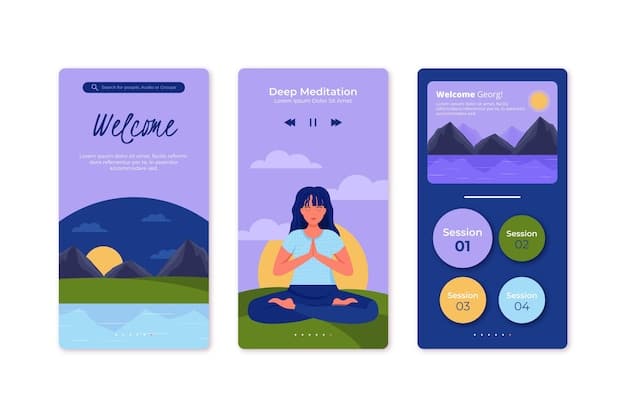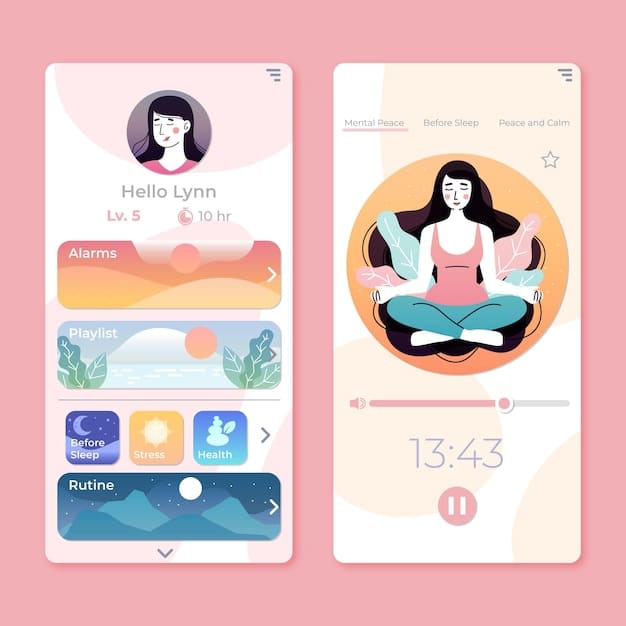Headspace vs. Calm: Which Mindfulness App is Right for You?

Headspace and Calm are leading mindfulness apps, each offering guided meditations, sleep aids, and stress reduction techniques; the best choice depends on individual needs, preferences, and mental health goals.
Choosing the right mindfulness app can be a game-changer for your mental well-being. This comparison/analysis: Headspace vs. Calm: Which app is best for your specific mental health needs? will guide you in making an informed decision, taking into account various factors to suit your unique requirements.
Headspace vs. Calm: An Overview
Headspace and Calm are two of the most popular mindfulness and meditation apps available. Both aim to reduce stress, improve sleep, and enhance overall mental wellness, but they approach these goals with distinct styles and features.
Understanding their core differences can help you choose the app that aligns best with your personal preferences and mental health needs.
Core Philosophies
Headspace emphasizes a structured, educational approach to meditation, often using animations and a friendly tone. Calm, on the other hand, focuses on creating a serene and immersive experience with nature sounds and soothing voices.
- Headspace: Structured learning and animated guidance.
- Calm: Immersive relaxation and ambient soundscapes.
Ultimately, both apps offer valuable tools for mindfulness. The ideal choice depends largely on what resonates with you personally.

Content and Features: What Do They Offer?
Both Headspace and Calm provide a wide range of content, including guided meditations, sleep stories, and relaxation exercises. However, the specific offerings and how they are presented differ significantly.
It’s essential to examine the breadth and depth of content to determine which app is best suited for your specific needs.
Meditation Programs
Headspace offers themed meditation programs covering topics such as stress, anxiety, and focus. Calm provides a broader range of meditations, including those focused on gratitude, relationships, and self-esteem.
Consider which topics are most relevant to your mental health goals when evaluating this difference.
Sleep Aids
Calm is particularly well-known for its sleep stories, narrated by celebrities and designed to lull you into a peaceful slumber. Headspace offers sleepcasts, which are longer audio experiences that create relaxing environments.
- Calm: Extensive library of sleep stories with celebrity narrators.
- Headspace: Sleepcasts and soundscapes designed for relaxation.
The choice between sleep stories and sleepcasts often comes down to personal preference for narrative vs. ambient sound experiences.
User Experience and Interface: Navigating the Apps
The user interface (UI) and overall user experience (UX) can significantly impact your engagement with a mindfulness app. A clean, intuitive design can make it easier to incorporate mindfulness into your daily routine.
Assess the navigation, visual design, and ease of use for both Headspace and Calm to determine which aligns better with your preferences.
Ease of Navigation
Headspace boasts a straightforward, structured interface with clear pathways to different meditation programs. Calm offers a more visually immersive experience, with a home screen that evolves with the time of day.
Think about whether you prefer a streamlined, goal-oriented approach or a more ambient, exploratory experience when navigating the app.
Customization
Both apps allow some level of customization, such as setting reminders and adjusting the length of meditation sessions. However, Calm offers greater personalization options, allowing you to create custom soundscapes and playlists.
- Headspace: Simple and focused navigation.
- Calm: Visually immersive with personalization options.
Ultimately, the best UI/UX depends on your individual preferences for visual appeal and ease of use.

Pricing and Subscription Models
Understanding the pricing structure of Headspace and Calm is essential before committing to a subscription. Both apps offer free trials and limited free content, but the full range of features requires a paid subscription.
Compare the costs and subscription options to determine which app offers the best value for your needs.
Subscription Costs
Headspace and Calm offer similar subscription models, with options for monthly or annual billing. It’s worth checking for promotional offers or discounts that may be available.
Consider whether you prefer the flexibility of a monthly subscription or the cost savings of an annual plan.
Free Content
Both apps provide some free content, including introductory meditation courses and select sleep stories. This can be a great way to sample the app before committing to a subscription.
- Headspace: Introductory courses and limited free content.
- Calm: Select sleep stories and guided meditations available for free.
Take advantage of the free content offered by both apps to get a feel for their styles and offerings.
Scientific Backing and Efficacy
The effectiveness of mindfulness apps is increasingly supported by scientific research. Both Headspace and Calm have conducted studies to evaluate the impact of their programs on mental health outcomes.
Consider the evidence-based research supporting each app when making your decision.
Research Studies
Headspace has been involved in research studies demonstrating its effectiveness in reducing stress and improving focus. Calm has also conducted studies showing positive effects on sleep and anxiety.
Review the available research to assess the credibility and efficacy of each app’s programs.
Expert Opinions
Mental health professionals often recommend both Headspace and Calm as tools for managing stress and promoting mindfulness. Their endorsements can provide further validation of their value.
- Headspace: Research-backed programs for stress reduction.
- Calm: Studies showing positive effects on sleep and anxiety.
While individual results may vary, the scientific backing provides confidence in the potential benefits of both apps.
Specific Mental Health Needs: Which App Is Better?
Ultimately, the best app for you will depend on your individual mental health needs. Consider whether you’re primarily seeking stress reduction, improved sleep, or enhanced focus when making your decision.
Assess your specific goals and preferences to determine which app is the better fit for you.
For Stress Reduction
Both Headspace and Calm offer excellent resources for stress reduction. Headspace’s structured programs may be more effective for those who prefer a guided approach, while Calm’s immersive experiences may resonate with those seeking deeper relaxation.
Consider which approach aligns best with your preferred methods for stress management.
For Sleep Improvement
Calm is widely recognized for its sleep stories and ambient soundscapes, making it a strong choice for those struggling with insomnia or sleep disturbances. Headspace offers sleepcasts, which provide longer audio experiences for relaxation.
- Headspace: Structured meditation for stress and focus.
- Calm: Immersive relaxation for sleep and anxiety.
Think about whether you prefer narrative-driven sleep aids or ambient soundscapes to help you fall asleep.
| Key Aspect | Brief Description |
|---|---|
| 🧘♀️ Meditation Style | Headspace: Structured; Calm: Immersive |
| 😴 Sleep Aids | Calm: Sleep Stories; Headspace: Sleepcasts |
| 🎨 User Interface | Headspace: Clean; Calm: Visual & Personalizable |
| 💰 Pricing | Similar subscription models with free trials |
FAQ Section
▼
Headspace focuses on structured, educational meditation using animations, while Calm emphasizes immersive relaxation with nature sounds and sleep stories. Their approaches target diverse user preferences.
▼
Calm is often favored for sleep due to its extensive library of sleep stories, but Headspace offers sleepcasts and relaxing soundscapes, catering to those seeking ambient audio relaxation.
▼
Yes, both Headspace and Calm provide free trials, allowing users to explore limited content before subscribing. This helps users decide which app fits their needs best.
▼
Yes, studies support both apps’ effectiveness in areas like stress reduction, anxiety relief, and sleep improvement. Such research enhances their credibility for mental wellness.
▼
Pricing is similar for both, offering monthly and yearly subscriptions. Promotional offers and discounts can vary, so check for ongoing deals to maximize savings.
Conclusion
In summary, both Headspace and Calm offer valuable tools for mindfulness and mental wellness, but cater to slightly different preferences. Headspace provides more structured, educational content, while Calm offers a more immersive, relaxation-focused experience. The best choice depends on your individual needs and preferences.





